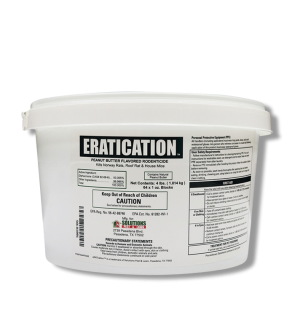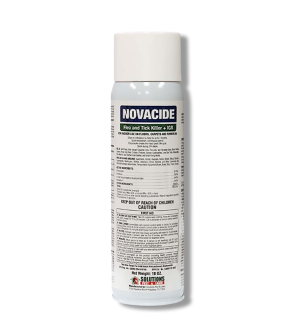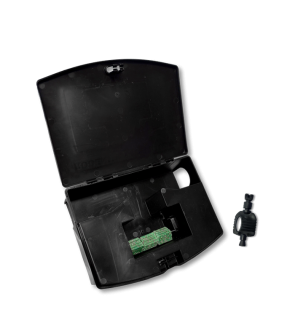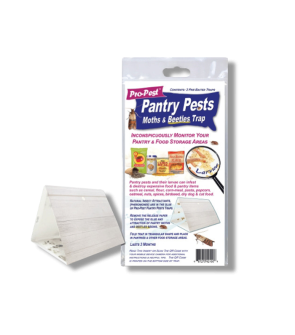How to Prevent Pests That Commonly Invade Food Products
Most Effective Products
How to Prevent Pests That Commonly Invade Food Products
This page is an expert DIY guide on treating common pantry pests such as drugstore beetles, flour beetles, grain beetle, Indian meal moth, rice weevil, and fruit flies. Follow this easy to use guide and the attached links to learn more about these food invading pests and the effective products to guarantee complete removal.
Stored product or pantry pests include several types of beetles, moths, weevils, and some species of flies that can infest whole grains or dry processed foods for people and animals such as dog food, pasta, rice, flour, and so forth. Pests like drugstore beetle, flour beetle, cigarette beetles, grain beetles, Indian meal moth, rice weevil, and fruit flies are usually the most experienced pantry pests. Often infestations are overlooked because most stored product pests are small, which can lead a homeowner to purchase infested food packaging or food items.
Once these food invading pests breach your homes interior they can be noticed by their crawling activity across ceilings or countertops, moths fly around the kitchen towards light sources, or the prescience of the pest itself in or near food packages and unpackaged food. Depending on the species of pests there could be several amounts of eggs in particular parts of your home that leads to high amount of larvae feeding activity.
For most species of pantry pests, there are multiple generations per year that complete their development within 4 weeks. Under ideal conditions, especially when pantry pest infestations remain undetected for long periods of time the adult pest have been known to survive and breed. Learning about the various pantry pests that threaten your home and food and then preparing an effective treatment plant will help to ensure your home remains pest-free and safe.
Store All Foodstuffs in Plastic Containers

Always remember that pantry pests can find their way into food products through the smallest of opening, inadequate sealing on the packaging, or packaging that is thin. Commonly infested products include grain and rice products such as flour, nuts, dried peas and beans, raisins, crackers, cookies, cake mix, dried dairy items, dried pastas, spices, dried fruits, candy, herbs, flowers, tobacco, dried dog and cat food, bird seed, fish food, rice, potpourri, and dried foliage on holiday décor items.
However, finding these pests in these objects does not necessarily mean infestation is in only in that food. Many stored product pests usually go undetected and travel into other parts of your home. Signs of infestation can be seen as webbing on container surfaces or food product and within soffits or underneath and between shelving in pantries. Other signs can be seen as tiny holes along the foods surface or a foul, musty odor.
Whether opened or not, food items including pet food should be placed in clean plastic containers with tight-fitting lids.
Organize Foods by Expiration Date

Food products and items that are left in storage for long time periods are most prone to pantry pest infestations. However, food of any age or condition can also become infested. At least once a month, you will want to open up your pantries or food storage areas and take out all items kept in these locations.
Once emptied clean all surfaces, top and bottom of shelving, corners, cracks, and crevices of food storage area. Immediately dispose of any spillage and crumbs of food, damage product containers, and expiration dates. Unfortunately, once a food product is infested it will have to be thrown away.
Once shelving is bare and cleaned of any food residues you can apply an effective pantry pest treatment. For pantry pest control, we recommend spraying an aerosol insecticide with a long-lasting residual and built-in insect growth regulator to prevent larvae and nymphs' of pest from developing into adults. Novacide Flea and Tick Killer has both of these features to control a wide variety of pantry pests, leading to effective elimination of pests and prevention of re-infestations.
To apply Novacide Flea and Tick Killer, you will shake the product well and hold it at a downward angle. Perform a spot treatment at the back of the cabinet shelves and along cracks and crevices. Apply short, controlled bursts of Novacide Flea and Tick Killer for 10 seconds in areas of 100 sq. ft. Avoid leaving run-off and moisture as this suggests over-application.
Repair Damages and Caulk

Like most insects, pantry pests can find their way in through the smallest of openings or most commonly by infesting food goods. Combined with their ability to live several weeks without food presents homeowners with the challenge in knowing if pantry pest infestations are still occurring.
Pantry pests can hide in holiday décor with dry foliage, cracks and crevices, drawers, and in other parts of the area that food is stored. Look for webbing and shed body parts if there are no present food materials as infestations remain close to past reliable food storage areas.
Thoroughly seal all cracks and crevices found not only in your pantry, but in other parts of your home such as around plumbing, faucets, under soffits, along baseboards, and in corners of rooms. This helps to eliminate hiding pests for not only pantry pests, but other household insects as well.
If shelving is old or damaged, consider replacing it with a new one.
Keep Storage Areas Dry and Clean

Just a few drops of water around your sink, floor, baseboards, and corners of pantries is enough sustain some species of pantry pests development. Once matured, these pests can find plenty of places to hide and breed if homes and food storage areas is cluttered. Regularly clean these areas and repair sources of moisture issues.
Also, adjust your shopping carts during grocery shopping as buying in bulk causes unnecessary piles of food. These piles of food creates veritable food sources and breeding sites for pantry pests since the items go a while without being used.
Continually monitor past or present infestation sites with Pro-Pest Pantry Moth. Place these triangle-shaped glue traps near food storages areas. This non-lethal trap contain a pheromone lure that is irresistible to most pantry pests like the Indian meal moth from their hiding places. Remove the paper from the glue adhesive on the Pro-Pest Pantry Moth. Place the Pro-Pest Pantry Moth in the corners of shelves or in areas where it won't become smashed. For flying pantry pest infestations, consider hanging this product in pantries away from food containers.
Eliminate Potential Rodent Infestations

If you have experienced past pantry pest infestations, this could be the cause of rodent and bird nesting activities within the inside or outside of homes. The nests of these pests are often created with masses of decaying plant matter, which can cause buildup of moisture and provide some sources of food through plants or by nuts, seeds, and other grain type of foods rodents or birds find.
Typically, during the fall rats and mice are known to store these grain type foods in walls, underneath and behind furniture, and hard to reach places in your home. Before purchasing any type of rodenticide products it would be best to perform an inspection for rats and mice to avoid financial cost. If you are worried about rats and mice in your home then these steps will help to prevent them.
If you have not already begun a process of elimination for rats, mice, and birds then begin by removing nests found in trees, within home insulation, attics, or basements. Pantry pests can breed in almost any type of food products, including rodenticide baits. Unfortunately, rodenticide baits does not harm or deter pantry pests. To increase current rodent infestations and pantry pests replace rodent bait on a daily basis.
We suggest using Eratication Rodent Bait within a tampered bait station such as Solutions Rat and Mouse Bait Station. Place these loaded bait station along your homes or structure foundation since this is the past most frequently traveled by rodents. Replace the baits with a glove covered hand at least once a day.
Key Takeaways
What are the Most Common Pantry Pests?
- The most common pantry pests that homeowners face in kitchens and other parts of their home is drugstore beetles, flour beetle, grain beetle, Indian meal moth, fruit fly, and rice weevil.
Are Pantry Pests Harmful?
- Pantry pests are not harmful to most homeowners health, but their activities does cause food to spoil. Any type of food and packaging damages can make homeowners experience some health problems.
Why Do Pantry Pests Keep Invading Home
- Homes that experience frequent pantry pest infestations could be harboring several factors for breeding and habitat. These pests harbor not only in food merchandise, but also cracks and crevices under sinks, around plumbing, corners of rooms and food storage areas, and along baseboards. Effectively sealing these cracks and crevices, repairing moisture issues, and disposal of expired and damaged food products helps to eliminate pantry pests habitats.














































































































































































































































































































































































































































































































































